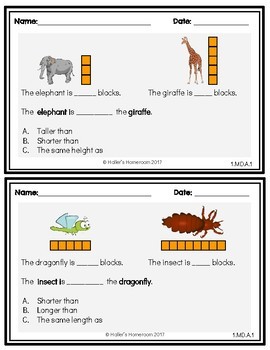1st Grade NWEA MAP Math Practice Questions [RIT 161-178]
- PDF
What educators are saying
Description
This product is designed to prepare your students for 1st grade NWEA MAPs Testing. There are over 130 questions aligned to both NWEA Maps Math Test and 1st Grade Common Core Math Standards. Use this product as quick and easy practice pages, exit tickets or whole group instruction. Enjoy all 21 pages of no-prep practice throughout the year!
Integrates these Common Core 1st Grade Math Standards:
Geometry:
1.G.A.1 -- Distinguish between defining attributes and non-defining attributes; build and draw shapes to possess defining attributes.
1.G.A.3 -- Partition circles and rectangles in two two and four equal shares, describe the shares with words like halves, fourths, quarters.
Measurement & Data:
1.MD.A.1 -- Order three objects by length; compare the lengths of two objects indirectly by using a third.
1.MD.A.2 -- Express the length of an object as a whole number of length units, by laying multiple copies of a shorter object (the length unit) end to end; understand that the length measurement of an object is the number of same-size length units that span it with no gaps or overlaps.
1.MD.B.3 -- Tell and write time in hours and half-hours using analog and digital clocks.
1.MD.C.4 -- Organize, represent, and interpret data with up to three categories; ask and answer questions about the total number of data points, how many in each category, and how many more or less are in one category than in another.
Number and Operations:
1.NBT.A.1 -- Count to 120, starting at any number less than 120. In this range, read and write numerals and represent a number of objects with a written numeral.
1.NBT.B.2 -- Understand that the two digits of a two-digit number represents amounts of tens and ones.
1.NBT.B.3 -- Compare two two-digit numbers based on meanings of the tens and ones digits, recording the results of comparisons with the symbols <, =, or <.
1.NBT.C.4 -- Add within 100, including adding a two-digit number and a one-digit number, and adding a two -digit number and a multiple of ten, using concrete model, drawings, or strategies based on place value, properties of operations, and/or the relationship between addition and subtraction.
1.NBT.C.5 -- Given a two-digit number, mentally find 10 more or 10 less than the number without having to count; explain the reasoning used.
Operations & Algebraic Thinking:
1.OA.A.1 -- Use addition and subtraction within 20 to solve world problems involving situations of adding to, taking from, putting together, taking apart, comparing, with unknowns in all positions.
1.OA.A.2 -- Solve word problems that call for addition of three whole numbers whose sum is less than or equal to 20.
1.OA.B.4 -- Understand subtraction as an unknown-addend problem.
1.OA.C.6 -- Add and subtract within 20, demonstrating fluency for addition and subtraction within 10.
1.OA.D.7 -- Understand the meaning of the equal sign, and determine if equations involving addition and subtraction are true or false.
1.OA.D.8 -- Determine the unknown whole number in an addition or subtraction equation relating three whole numbers.
――――――――――――――――――――――――――――――――――――――――――――――――
Other Products You May Enjoy:
2nd Grade NWEA MAPS Math Practice Pages
Citing Evidence Sentence Stem Cards & Poster
⁙⁙⁙⁙⁙⁙⁙⁙⁙⁙⁙⁙⁙⁙⁙⁙⁙⁙⁙⁙⁙⁙⁙⁙⁙⁙⁙⁙⁙⁙⁙⁙⁙⁙⁙⁙⁙⁙⁙⁙⁙⁙⁙⁙⁙⁙⁙⁙⁙⁙⁙⁙⁙⁙⁙⁙⁙⁙⁙⁙⁙⁙⁙⁙⁙⁙⁙⁙⁙⁙⁙⁙⁙⁙⁙⁙⁙⁙⁙⁙⁙⁙⁙
Customer Tips:
Please go to your MY PURCHASES pages (you may need to login). Beside each purchase you can give a quick rating and leave a comment for the product. Each time you give feedback, TPT gives you feedback credits that you can use to lower the costs of other purchases. I value your feedback and look forward to hearing the value these products add to your classroom.
Be first to know about discounts, freebies and new products! Look for the green star next to my store logo. Click it and become a follower!
⁙⁙⁙⁙⁙⁙⁙⁙⁙⁙⁙⁙⁙⁙⁙⁙⁙⁙⁙⁙⁙⁙⁙⁙⁙⁙⁙⁙⁙⁙⁙⁙⁙⁙⁙⁙⁙⁙⁙⁙⁙⁙⁙⁙⁙⁙⁙⁙⁙⁙⁙⁙⁙⁙⁙⁙⁙⁙⁙⁙⁙⁙⁙⁙⁙⁙⁙⁙⁙⁙⁙⁙⁙⁙⁙⁙⁙⁙⁙⁙⁙⁙⁙
Check out the rest of my Store
Click here if you’d like to start your own Store





